Cookie banner
We use cookies and other tracking technologies to improve your browsing experience on our site, show personalized content and targeted ads, analyze site traffic, and understand where our audiences come from. To learn more or opt-out, read our Cookie Policy . Please also read our Privacy Notice and Terms of Use , which became effective December 20, 2019.
By choosing I Accept , you consent to our use of cookies and other tracking technologies.

Site search
- Los Angeles
- San Francisco
- Archive.curbed.com
- For Sale in LA
- For Rent in LA
- Curbed Comparisons
- Neighborhoods
- Real Estate Market Reports
- Rental Market Reports
- Homelessness
- Development News
- Transportation
- Architecture
Filed under:
- Pasadena & Environs
- Los Angeles Architecture
Take a video tour through Pasadena’s iconic Gamble House
A quick introduction to an important and beautiful Craftsman home
Pasadena ’s sprawling Craftsman masterpiece, the Gamble House , has been called one of the 10 homes that changed America .
Now, a video from Curbed gives a peek inside the Los Angeles architectural icon. It highlights a few of the elements that make the house exceptional and offers a brief tour and primer for those who haven’t been lucky enough to visit in person.
Designed by brothers Charles and Henry Greene in 1908, the stately house was created as a winter home for David Gamble, a Proctor & Gamble heir, and his wife, Mary. The house was designed in the Arts and Crafts style, which, as the name implies, emphasizes incredible craftsmanship.
The video shows myriad examples, including intricate stained glass windows and woodwork that allows for secret doors to seamlessly blend into the walls of the house.
Since 1978, the Gamble House has been owned by the city of Pasadena and run by the University of Southern California. It operates as a museum with regular public tours .
:no_upscale()/cdn.vox-cdn.com/uploads/chorus_asset/file/9972411/564088413.jpg.jpg)
- The Gamble House [Curbed]
- Watch How Two LA Homes Changed America [Curbed LA]
The Gamble House
The beginner’s guide to los angeles.
- Should you move to LA?
- How to pick a neighborhood
- Locals’ guides to their LA neighborhoods
- Quiz: Which neighborhood should you live in?
- Which LA neighborhood do you really live in?
- Why I moved from New York to LA
- 16 comparisons to show exactly how enormous Los Angeles is
- Is it better to buy or rent?
- What you can buy, what you can rent
- The Los Angeles renters’ guide
- A guide to rent control
- 10 renters’ rights your landlord doesn’t want you to know
- 13 glamorous apartments from Hollywood’s Golden Age
- The best rental apps for LA apartment hunting
- Feast your eyes on Curbed’s best LA home tours
- The Los Angeles homebuying guide
- What it’s like to buy a house in Los Angeles
- Buying vacant lots in LA: 6 things to know
- Will your building hold up in a major earthquake?
- 9 tips for riding Metro like a pro
- Why we can’t rely on Metro’s countdown clocks
- Metro’s declining ridership, explained
- The most anticipated transit projects opening in time for the 2028 LA Olympics
- Metro’s Regional Connector, explained
- A quick guide to LAX
- Four LA bike rides: Explore the city on two wheels
- 8 secrets you learn being an Uber driver in Los Angeles
- LA’s most beautiful bike path: The Strand through Santa Monica
- LA’s worst commute: The hellish drive from East Hollywood to Santa Monica
- Old photos show the evolution of transportation in LA
- 26 must-do things in LA this summer
- The 11 best hotel pools, mapped
- The best things to do with kids that aren’t Disneyland
- Dodger Stadium: The ultimate guide to LA’s ballpark
- The Hollywood Sign: The 7 best hikes and viewing options
- 12 of the city’s most glorious movie theaters
- A guide to surviving—and enjoying—The Grove
- Los Angeles heatwave hangouts: 24 free and air conditioned places to beat the heat
- LA’s coolest ride: Angels Flight is a trip back in time
- An illustrated guide to Los Angeles architecture
- The ultimate guide to Los Angeles movie and television filming locations
- The 20 most iconic buildings in the city, mapped
- The Case Study houses that made Los Angeles a modernist mecca
- An introduction to Googie, SoCal's signature architectural style
- The 10 best Art Deco buildings
- A complete guide to Grand Central Market
- 18 places where black architects left their mark
- Mapped: The historic, stately homes of West Adams Boulevard
- A full tour of Frank Lloyd Wright’s Hollyhock House
- Inside the iconic John Lautner Residence
- The sordid and possibly murderous secrets of the Sowden House
- Take a tour through LA’s Art Deco City Hall
- Hikes in Los Angeles: 9 trails with spectacular endings
- 7 hikes off the Gold Line
- 10 questions with LA’s hiking guru Casey Schreiner of Modern Hiker
- 29 secret gardens and green spaces hidden around LA
- Los Angeles picnic spots: 20 of the best places to lay out a blanket
- The city’s enchanting jacaranda trees are key to its future
- Who Will Save LA’s Trees?
- The myth and truth behind the Los Angeles ‘Devil Winds’
- Is the city losing its marine layer?
- The 18 cleanest beaches
- 101 things to love about Los Angeles
- A video primer on the unique, shimmery light of Los Angeles
- Building a Downtown for everyone
- Seize the Hollywood Sign
- LA history 101
- The thrill of Sugar Hill
- How ’80s pop culture typecast the Valley
- 14 must-follow Instagram accounts for LA lovers
- 7 Ways to Help L.A.’s Homeless Residents
- 19 small towns around LA you should absolutely visit
- Ghost towns of the desert
- The best places to stay on a road trip from Los Angeles
- 23 things to do in the California desert
- The best hotels in Palm Springs
- California’s best midcentury motels, mapped
- The West Coast's 15 must-see midcentury modern buildings
- 6 awesome campsites within about an hour of Los Angeles
- Where to find fall colors near Los Angeles
Loading comments...
Share this story.

The Gamble House

THE GAMBLE HOUSE – ARCHITECTURE AS FINE ART
The mission of The Gamble House is to inspire the public’s appreciation and understanding of architecture as a fine art through the example of The Gamble House, the most complete and best-preserved work of American Arts and Crafts architects Charles and Henry Greene.
This will be achieved by:
• Preserving The Gamble House, its furnishings, collection, and grounds to nationally-recognized standards of conservation;
• Providing an exemplary program of public access that interprets the architecture of The Gamble House, and its collections, in a relevant, educational and engaging way;
• Providing education programs that enhance the public’s understanding of The Gamble House within the context of architectural and cultural history, and;
• Pursuing a mutually supportive relationship with the City of Pasadena in the interest of meeting our mission and adhering to the 1966 family gift agreement.
You are using an outdated browser. Please upgrade your browser to access savingplaces.org.
National Trust for Historic Preservation: Return to home page
Site navigation, america's 11 most endangered historic places.
This annual list raises awareness about the threats facing some of the nation's greatest treasures.
Join The National Trust
Your support is critical to ensuring our success in protecting America's places that matter for future generations.
Take Action Today
Tell lawmakers and decision makers that our nation's historic places matter.
Save Places
- PastForward National Preservation Conference
- Preservation Leadership Forum
- Grant Programs
- National Preservation Awards
- National Trust Historic Sites
Explore this remarkable collection of historic sites online.
Places Near You
Discover historic places across the nation and close to home.
Preservation Magazine & More
Read stories of people saving places, as featured in our award-winning magazine and on our website.
Explore Places
Distinctive Destinations
- Historic Hotels of America
- National Trust Tours
- Preservation Magazine
Saving America’s Historic Sites
Discover how these unique places connect Americans to their past—and to each other.
Telling the Full American Story
Explore the diverse pasts that weave our multicultural nation together.
Building Stronger Communities
Learn how historic preservation can unlock your community's potential.
Investing in Preservation’s Future
Take a look at all the ways we're growing the field to save places.
About Saving Places
- About the National Trust
- African American Cultural Heritage Action Fund
- Where Women Made History
- National Fund for Sacred Places
- Main Street America
- Historic Tax Credits
Support the National Trust Today
Make a vibrant future possible for our nation's most important places.
Leave A Legacy
Protect the past by remembering the National Trust in your will or estate plan.
Support Preservation As You Shop, Travel, and Play
Discover the easy ways you can incorporate preservation into your everyday life—and support a terrific cause as you go.
Support Us Today
- Gift Memberships
- Planned Giving
- Leadership Giving
- Monthly Giving

photo by: Alex Vertikoff
The Gamble House
- Address 4 Westmoreland Place Pasadena, California 91103
- Hours Tuesday 11:30 a.m.–1:30 p.m. Thursday–Friday 11:30 a.m.–4:00 p.m. Saturday–Sunday 12:00 p.m.–4:00 p.m.
- Phone 626-793-3334
Visit The Gamble House

The Gamble House in Pasadena, California, is an outstanding example of American Arts and Crafts-style architecture. The house and furnishings were designed by architects Charles and Henry Greene in 1908 for David and Mary Gamble of the Procter & Gamble Company. The house, designated a National Historic Landmark in 1978, is owned by the City of Pasadena and operated by the University of Southern California.
Benefits for National Trust Members
10% Off Regular Public Tour
Join the National Trust to enjoy a host of membership benefits.
Related Stories

Explore More Places

The Gamble House Launches a Fresh Tour
The gardens & gables experience gives fans of the world-famous craftsman home the chance to explore the grounds., by alysia gray painter • published september 15, 2020 • updated on september 15, 2020 at 11:16 am, what to know.
- $15 for an hour-long open-air tour
- Safe practices are in place, so please review before booking
Eagerness to enter the Gamble House ?
So many Craftsman aficionados have felt that zing of discovery, the anticipation of entering a home that is truly a walk-through work of art.
The Pasadena landmark's living spaces, from its grand and wide entry to its cozy, wood-rich bedrooms, regularly attract fans who are eager to explore the masterwork of Charles and Henry Greene.
But the outdoor areas of the 1908-09 gem are also part of the fabulous whole, a flowery, stone-lined complement to the historic house's iconic interiors.
Many visitors to the Westmoreland Place destination do walk the grounds, following an inside look-around. But the gardens stand in a fresh spotlight, due to the temporary closure of the Gamble House's enclosed spaces.
That spotlight has grown brighter thanks to the new Gardens & Gables tour, an open-air, docent-led stroll that takes around an hour.
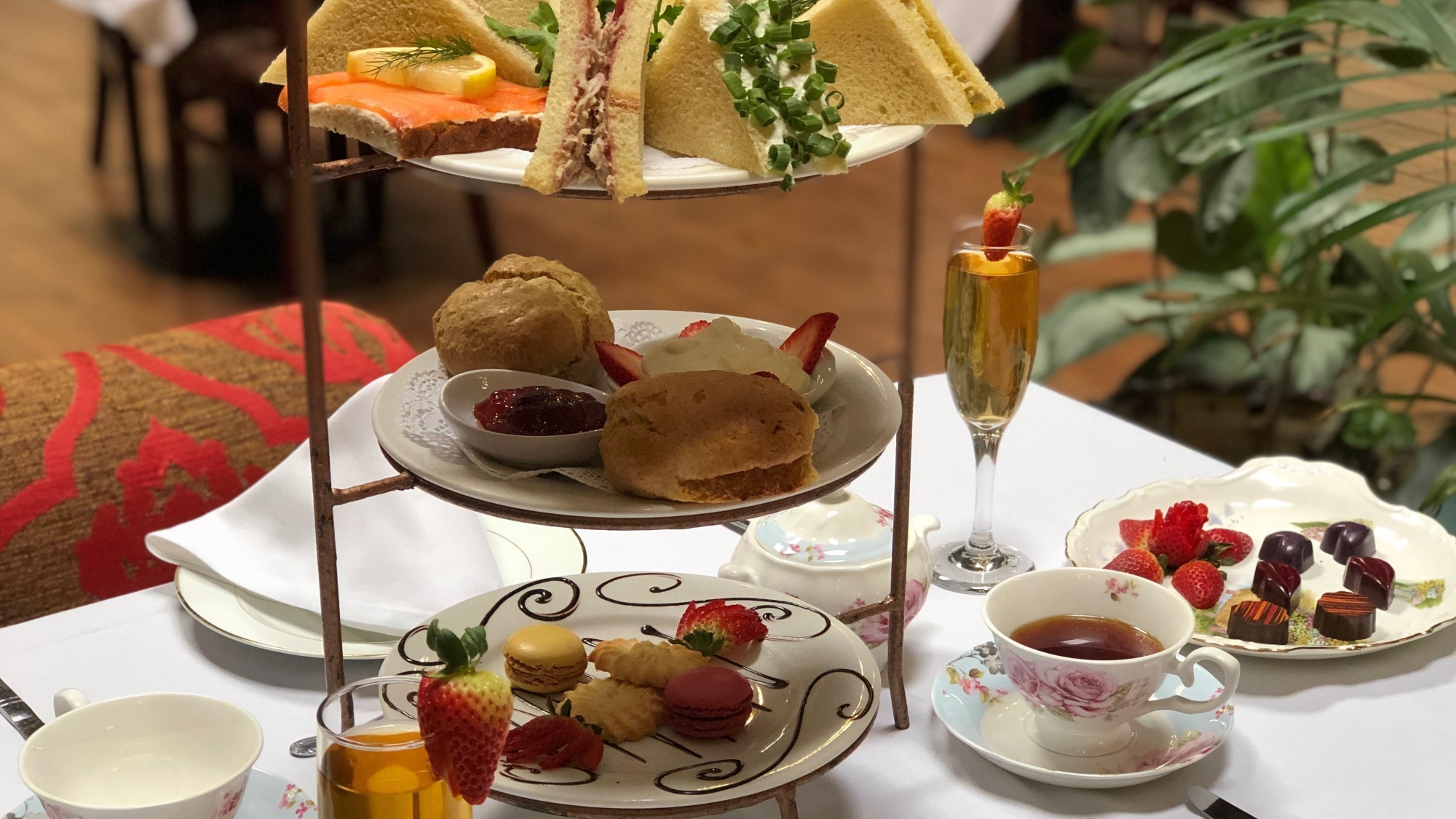
Happy 30th, Chado Tea
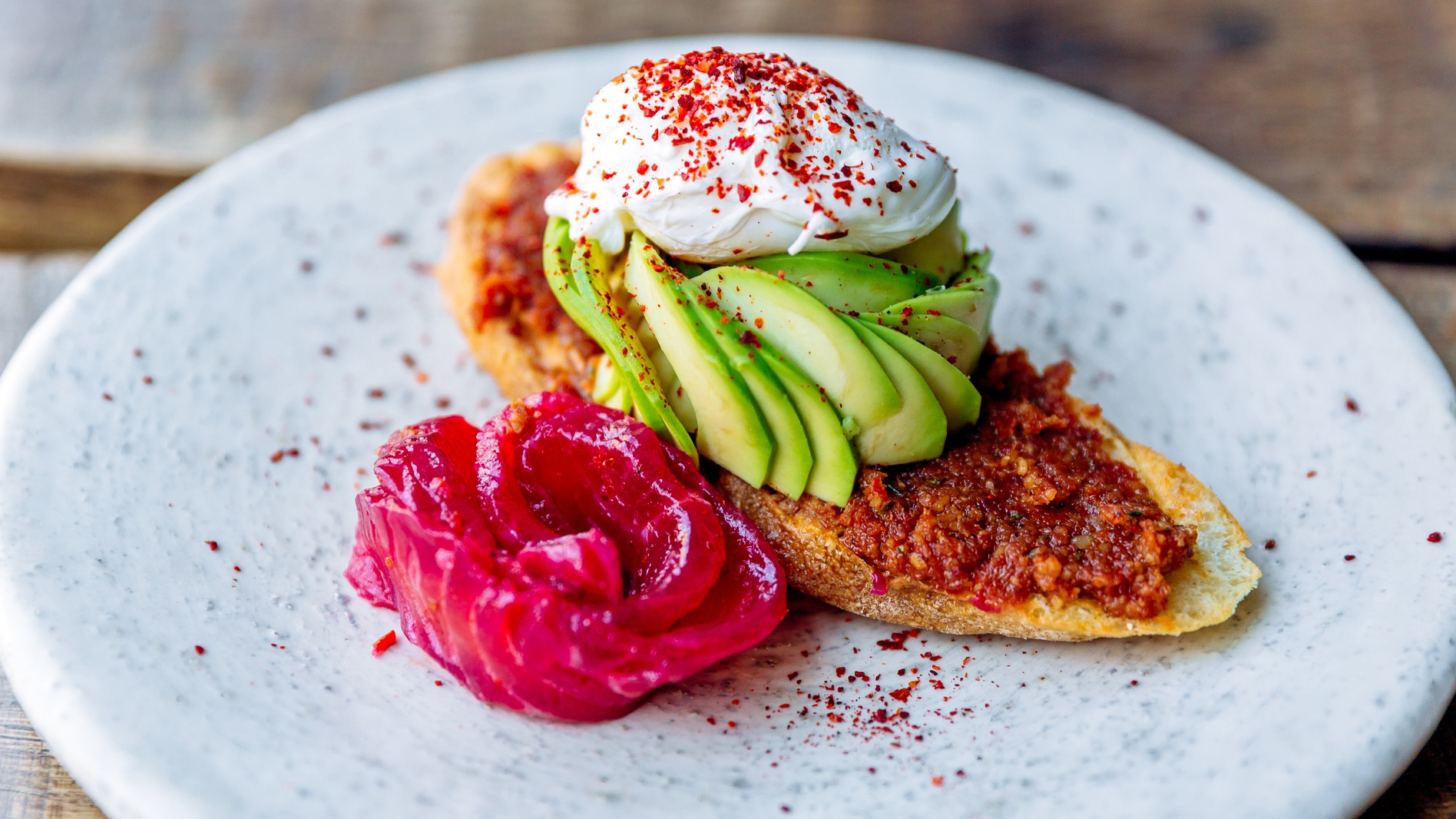
dine L.A. Opens, With Options for Takeout and Delivery
During that hour you'll learn about the house's design, yes, even as you stand beyond its walls and not inside. "The development of the gardens, landscape, terraces, and porches as a setting for early 20th century outdoor living," will also be a tour topic.
And if joinery is your jam, that, too, will serve as a focus, dear architecture buffs. The Gamble House is, after all, a nexus for satisfying joinery, a timeless craft that reached a zenith in the home's exquisite interior staircase.
The cost is $15, and there are safety protocols to keep in mind, like face coverings and physical distancing.
If you'd like a fresh face covering, you can find them at the Gamble House bookstore.
The store is only open to online orders and curbside pick-up at the moment, keep in mind, so you want to procure any Gamble-related goodies well before you go, or plan on buying after you return home.
Due to air quality issues, please confirm that tours are running before visiting the Gamble House, or any open-air destination.
This article tagged under:
Gamble House
Photos & videos.
See all 509 photos

See All 509
Review Highlights

“ The Gamble House in Pasadena by Green and Greene is not just a California treasure, it's a national treasure. ” in 33 reviews

“ Got to see a lot of the old Craftsman styles as well as get a little history of the Gamble family . ” in 20 reviews

“ What's not to love about exploring an architectures gem and being able to ask a docent all kinds of questions. ” in 36 reviews
About the Business
Business owner information
Alexandra R.
Tour the Gamble House and experience architecture as a fine art. A bold architectural statement when it was built as a winter residence in 1908, today The Gamble House recalls a grand age when great architects to the wealthy designed not only their homes but nearly everything inside: light fixtures, furniture, stained-glass windows, rugs, and even the fireplace tools! Architects Greene & Greene conceived this "ultimate bungalow" for David and Mary Gamble, philanthropists and heirs to the Procter & Gamble fortune. Today their house in Pasadena, CA is known internationally as one of the world's great achievements in domestic design and craftsmanship. …
Location & Hours
Suggest an edit
4 Westmoreland Pl
Pasadena, CA 91103
Amenities and More
Ask the community.
Ask a question
Yelp users haven’t asked any questions yet about Gamble House .
Recommended Reviews
- 1 star rating Not good
- 2 star rating Could’ve been better
- 3 star rating OK
- 4 star rating Good
- 5 star rating Great
Select your rating
Overall rating
155 reviews

A beautiful tribute to architecture and design that's well maintained and a lovely insight into life and times of the past. Do a guided tour here and stop by the gift shop!

GAMBLE HOUSE IS AN ARTS AND CRAFT MASTERPIECE ============================================ My good friend and I booked tickets for a one-hour docent led tour on Thursday, April 27, 2023. It was very easy to get tickets online for the 11:30 a.m. tour. They recommend that you arrive ten minutes early to check-in at the bookstore. I would also recommend that maybe you try to get there twenty minutes before to find parking. We parked in the church parking to the south and I was a bit nervous I might get a ticket. Thankfully I did not. THE ONE-HOUR DOCENT LED TOUR ============================= Our docent was great and gave us so many details about Greene and Greene, the architects, David and Mary Gamble, the original owners, and the next two generations of Gambles who owned the house before it was donated to the City of Pasadena. The cost of a one-hour docent led tour is $15.00. MISC. INFO: 1. Check in at the Bookstore which is north of the house. If you need to use a restroom they have one there. There are no restrooms at the Gamble House. 2. Go up the stairs in front of the house and turn right to walk over to the covered patio. That is where you will meet your docent. 3. Don't bring a big handbag. The docents will ask you to leave it in a room in the house. I would not feel comfortable with that with all the tour groups walking around. 4. Don't touch or lean on anything. Most of the furniture and cabinets are original. One lady on our tour leaned up against some cabinets in the kitchen and the docent spoke to her. 5. There are lots of nice things in the gift shop. I bought a little book called "Self-Guided Neighborhood Walking Tour" for $2.00. I can't wait to go back with friends to do our own walking tours around the Gamble House, the Huntington Library and Bungalow Heaven.

See all photos from Cydney M. for Gamble House

The Gamble House, aka, Doc. Emmit Brown's crib is located in Pasadena and is an architectural masterpiece that take you on a journey back through time. I went in thinking I will learn some things about back to the future trivia, etc, but I was bitterlysweetly (I know that's not a word lol) suprised. From the moment we set foot on its meticulously maintained grounds, we was transported to a bygone era, where attention to detail and craftsmanship shocased in everything we came across. We got tickets for "Behind The Velvet Rope" tour. The visit includes a guided tour led by knowledgeable docents who brought the history of the Gamble House to life with their years of experience, passion towards preservation of art and architecture and expertise acquired from over a decade. They regaled us with captivating stories about the Gamble family and pointed out the architectural features that make this house truly unique and one-of-a-kind. For the back to the future fans, I'm afraid there isn't much here, other than seeing the Doc's house and garage from the outside. A little tip; if you are looking to see the inside of the house that was shown in the movie, check out Robert R. Blacker House which is less than 5 miles away. One of the little secrets the dosants shared with me while they rolled their eyes! Lol JK. They were super sweet! That said, I wholeheartedly recommend visiting the Gamble House in Pasadena. It is an opportunity to witness architectural brilliance, get a glimpse into history and get transported to an era of unparalleled beauty, creativity and masterpiece. Buying tickets in advance are recommended but not always necessary unless you are looking to do a special tour like behind the velvet rope. Have fun!

See all photos from Hosh S. for Gamble House

What a neat spot! Finally discovering attractions in my local neighborhood and I stumbled on the Gamble House! It's known for their craftsman architecture and is actually shown in a decent number of movies (after doing some research). The house is open for tours on Tuesdays, and Thursdays through Sundays with tickets around $15. Advanced reservation is recommended! The house itself has a comforting yet grand vibe. It's described as a 'bungalow vibe' and I can definitely see it! The backyard garden is also very serene. Great little pocket of architecture history in Pasadena worth checking out. If not on the tour, at least in a stroll to admire!

This house is huge and beautiful! Open for tours on certain days, look ahead of time and buy tickets. There is also a bookstore/gift shop next door to the house that you can buy souvenirs at! The Gamble House is truly beautiful inside and out. So elegant. Highly recommend visiting! Also I recommend reading the website's FAQ section, as there are many rules such as no flashes while taking photos, notes on accessibility, and more.

See all photos from Alex D. for Gamble House

I love this home so much, I took a back to back tour 2 days in a row. The craftsmanship of this home cannot be seen in modern home builds. The types of wood used can no longer be found. THIS home is truly a piece of art!!! LOVE! If you appreciate architecture, interior design and furniture, you'd enjoy the tours as much as I did! I plan to go back again and again! Enjoy! ~~~

I've been to to Gamble house before and I was amazed. This time our docent was so rude. I just wanted to take a picture the docent pretty much yelled at me and told me to stick to my group.

Nice piece of late 19th to early 20th century architectural achievement. Our docent could have been better but that the risk you take with volunteers. I was a little disappointed that they downplayed Back to the Futures history with the house, for most people that is why they check the place out.

house was beautiful but the one star is for the docent who gave us our tour. the first question he asked us was if we spoke english. the group of us were talking amongst ourselves while waiting for the tour to start and it was obvious we spoke english but i guess since we were all Asian American he assumed otherwise. he continued to be short and slightly condescending when we would ask questions about the house including when we asked if we could bring in a wheelchair inside the house for my mother in law to access the first floor. he gave a short "no" and walked on. keep in mind that the lady at the check in said we could.
Arts & Crafts architecture at its best! Had been wanting to visit for years, finally came to be!! Was not disappointed! Docent was very knowledgeable, friendly, and kept to a great pace throughout the home. Was able to see the great detail of the house. Woodwork is AMAZING!!! Was surprised with the attic!! Much to see indoors and out! HIGHLY recommend!!

See all photos from Linda Y. for Gamble House
12 other reviews that are not currently recommended
Collections Including Gamble House

Playin' in Pasadena
By Claudia B.

Fun Stuff To Do in Los Angeles

SoCal Discoveries!!
By Jorgie W.

My Neighborhood

Museums, Landmarks, & Gardens
By Kimberly S.

Architecture Gems in Los Angeles

to LIVE and DIE in LA ...
By James G.

Top Places for Art in Los Angeles

LA Things To Explore
By Stephanie L.

some architectural interests...
People Also Viewed

Charles F Lummis Home & Garden

Heritage Square Museum

Millard House

Old Mill Foundation

Queen Anne Cottage & Coach Barn

Hollyhock House

Doheny Mansion

Carroll Ave

Michael Myers Halloween House

Pyrenees Castle
Best of Pasadena
Things to do in Pasadena
Other Landmarks Nearby
Find more Landmarks near Gamble House
People found Gamble House by searching for…
Filoli Garden Pasadena
Frank Lloyd Wright House Pasadena
Haunted Places Pasadena
Historic Homes Pasadena
Historic Mansion Pasadena
Pasadena Home Historic Pasadena
Proctor House Pasadena
Rainy Day Activities Pasadena
Things To See Pasadena
Tourist Attractions Pasadena
Wedding Venues Pasadena
What To Do Pasadena

Browse Nearby
Restaurants
Scenic Drive
Bike Rentals
Campgrounds
Landmarks & Historical Buildings Near Me
Pokestops Near Me

Iconic Perspectives: Greene & Greene's Gamble House

Beginning the tours with such an artisanal masterpiece showed us how much dedicated work goes into keeping these iconic structures alive. Designed and built by Charles and Henry Greene in 1908, the Gamble House in Pasadena, California is known to be the most complete and best preserved examples of the American Arts and Crafts style of architecture that was thriving at the time—in fact, many believe it actually helped define the movement.
Not only did the Greene brothers create the structure, but they also designed the furnishings, lighting, textiles, and intricate architectural details throughout the house. Along with about 10 local craftsmen, the Greenes worked tirelessly over the course of two years to formulate every little detail of the house.

The Gamble House, which was built by the Greene Brothers for the Proctor and Gamble family in 1908, is known as one of the most authentic and well-preserved examples of the Arts and Crafts movement that spread like a wildfire in the Los Angeles neighborhood of Pasadena.
It all began when David and Mary Gamble of the Proctor and Gamble family packed up their belongings and moved from Ohio to sunny California in 1893. At the time, many families from booming cities in the Midwest and on the East Coast were migrating to California in the hopes of a cleaner, warmer, healthier lifestyle. Many of them settled in Southern California and a large group set up camp in Pasadena. Here, the Greene brothers built multiple homes in a similar style as the Gamble House, in which they termed the "ultimate bungalows." Built to fit in with the natural environment, this experimental movement emphasized a connection to the outdoors in a way that’s specific to Southern California living.
The Proctor and Gamble family found the perfect fit when they hired the Greenes. Since their father was a respiratory physician, the brothers also believed in the importance of living a healthy lifestyle full of circulating air and sunshine. They incorporating this theory into each of the houses they designed in their careers.

Inspired by Japanese architecture, the Greenes ensured that there were no hard edges to be found on the property. Everything is round and smoothed out, including the bricks in the yard. The exterior of the house is lined with Douglas fir and the extended overhanging eaves act as cooling agents while protecting the porch from the rain.
In order to create such a precise work of art, the Greenes worked with Peter and John Hall, two brothers from Stockholm who were known as master woodworkers, stair builders, and furniture craftsmen. Additionally, they worked closely with Emil Lang, a glass artisan who was responsible for the stained glass that fills the house.
The design details throughout are clearly influenced by Japanese architecture, which they first became enamored with during a cross country trip. While making their way from Ohio to Pasadena, they first experienced it when they stopped by the World’s Columbian Exhibition in Chicago—also known as the Chicago World’s Fair—and visited the Ho-o-den Japanese Pavilion. The house is filled with repeated motifs that are regularly found in traditional Japanese design. Along with precise joinery throughout the entire home, our docent tour guides pointed out multiple other influences including overhanging eaves, darkened mortars, and scarf joints. The most prominent motif that's repeated in groups of three is the Suba, a Japanese design that references the protective plate between the blade and handle of a samurai sword. It can be found throughout the woodworking, glass design, and furniture.
Even though this house might look overtly traditional, it was forward-thinking for its day and was even one of the first houses in the area to have electricity. Additionally, an internal intercom system was installed in which members of the household used to communicate with one another.

Shown here is one of the living spaces that’s filled with intricate woodworking and handcrafted furniture. The various spaces of the house are separated by different wood patterns on the floor. The chevron pattern denotes public formal spaces for entertaining, while the linear horizontal flooring presents private, informal spaces where the family would spend their time.
As we were walking through the house, it was clear that the materials the Greenes used came from multiple surprising sources. Though they used maple throughout the house and black walnut in the furniture, they also utilized woods from Myanmar and the Dominican Republic, along with domestic woods from Oregon. Some of the most impressive details could be found in the furniture and lighting fixtures, where they also used a mix of special materials including abalone shell inlays, ebony details, semi-precious stones, leather straps, and carvings of subas and clouds.

Also found throughout the house are complete collections of art tile, pottery, and art glass that were compiled by the resident family. The Greene brothers took these key pieces into consideration when designing the house, and they still exist there today. This dining space reveals a smooth, velvety glow that permeates the space, which is created by a lack of direct lighting. The walls are covered with canvas, which were varnished into a wet plaster.
Preservationists had originally finished the exterior eaves with a type of soap stain, which ended up wearing off over the years. To protect the exposed structure, they started to apply a preservative, which ended up oxidizing and turned the exterior green and some of the wood black. When a team revisited the project to try and achieve its original colors, they removed the old preservative and replaced the original screens with ones made of copper. They also had to manually remove a toxic epoxy that had filled the wood in the past.

The home is surrounded by open porches that are constructed of cedar. The house’s art glass—shown here on the front door—acted as a way to bring light into the space before there was electricity.
Ever since the house was designated as a National Historic Landmark in 1978, it’s been owned by the City of Pasadena and is operated by the University of Southern California. Marking the 50th anniversary of the house being gifted to the city, this entire year has been filled with celebratory events including lecture series, tours, family-friendly days, and reunion events. They're also planning to reveal a documentary that's been in the works by well-known film producer, Don Hahn.

The gardens and ponds throughout the property are consistently kept up. To accommodate a eucalyptus tree that existed on the land before the house was built, the Greenes created notches in the roof line where it could stand.
Similar to the rest of the residences on the tours, a connection to the outdoors is inseparable from the history of the house and to this day, the restoration team is keeping the intention alive. In fact, Isabelle Greene —the granddaughter of Henry Greene and landscape architect—has been working on revamping the garden that has been forgotten for years. She’ll be bringing it back to life based on the original vision that Mary Gamble had created. It had been her cherished cutting garden and was a place where Isabelle spent much of her childhood.

The prominent amount of lush outdoor space and sleeping porches on the property exhibit an appreciation that the Greenes had for nature. It’s filled with ponds, lawns, and voluminous trees and greenery.
Learn more about the 2016 International Iconic Houses Conference here —where we were given the chance to tour this incredible home.
Last Updated
Get the Pro Newsletter
What’s new in the design world? Stay up to date with our essential dispatches for design professionals.
The Royal Tour
The gamble house and the architecture of greene and greene.
The exposed wood staircase grabs my attention and refuses to let it go. Beams at right angles, ends sticking out, and a banister that is made of a single piece of wood despite looking like it should be several – these are only a couple of the incredible features of a single part of the awesome Gamble House, a mansion in Pasadena. The entire structure resembles a cross between a Spanish colonial and a Japanese temple, a unique style that is intentional, the work of the famed architectural brothers Charles and Henry Greene.

A tour of the Gamble House is a worthwhile endeavor for lovers of architecture and of history. It is the story of a new architectural style that would become the rage in Pasadena as the elite clamored for a home designed by Greene and Greene. It is the tale of the heir to the Gamble fortune (of Proctor and Gamble) and of the history of Pasadena’s “millionaires row.” And it is a glimpse into a wholly remarkable home full of wholly remarkable features, little touches that make this place stand out among the gems of the architectural world.
In 1908, David Gamble, heir to the Gamble fortune, and his wife Mary commissioned the architects Greene and Greene to build them a modest mansion in Pasadena along what would become known as “millionaires row” on Orange Grove Boulevard. The house was to be full of the most modern features: electric lighting throughout, a garage for their automobile (electric first, and then gasoline-powered – requiring a gas pump to be installed in the garage), and immense air circulation to prevent disease. The couple would live in the home until their deaths in 1923 and 1929, respectively, with Mary’s sister and then the couple’s son occupying it until 1966, when it was given to the city of Pasadena.
My tour guide, Delores, is full of fun stories about the home and its occupants, and one of my favorites details the turn-over to the city. She tells me that the Gambles intended to sell the home, but overheard the prospective buyer say that she intended to cover up many of the home’s wood features. That so enraged Mrs. Gamble that she pulled the house off the market, and instead donated it.
It is the woodwork of the Gamble House that stands out, and would come to define the style of Greene and Greene. Beams overhang patios, reminiscent of Japanese pagodas, their joints making fun shapes in the sun and shade. Carvings adorn many of the walls. But the highlight is the main staircase. Ascending to the second floor (the house has three floors, plus a finished basement, though the top was just used by the Gambles for storage and air flow), it creates right angles over built-in seating, and framing the front door. (The door itself is overly wide, part of a purposeful tactic of highlighting the horizontal features of the house.)

The interior of the Gamble House is surprisingly dark. While it is lit with electricity, the newness of light bulbs – and the belief by Mrs. Gamble that looking at a bulb was bad for ones health – led to a dimness that is odd for modernity, but would have been comfortable in a time where most people were accustomed to candlelight. Windows are plentiful, but the overhanging balconies (the three main bedrooms – the master bedroom, the room of the Gambles’ son who lived with them when not at boarding school, and Mary’s sister’s room – have large sleeping porches, as sleeping outdoors was thought to be better for the health and mosquitoes were not yet an issue in Pasadena), prevent too much direct sunlight from permeating the home’s interior.

Charles and Henry Greene didn’t only design the home. They also designed the majority of the furniture, light fixtures, and even door frames. Many of the features are styled with Asian touches; others prominently display the Gamble family crest (a stork holding a rose). Some rooms are furnished in items meant to match a favorite vase or piece of artwork that Mrs. Gamble wanted to display, while others are simply done for the sake of beauty. In Mary’s sister’s room, the furniture is designed for her small stature; Julie stood only 4’8”.

Perhaps the most interesting feature of the Gamble House is the lack of exposed nails and screws. (The rumor that the home doesn’t use any is completely untrue.) Greene and Greene covered every nail and screw in the house with a wooden button, making for both interesting patterns and a sense of the house being of only wood. This extends to the furniture, as well, as Delores points out.
While the Gamble House is the most famous, it is far from the only Greene and Greene house in Pasadena. In fact, just a short walk away is a block featuring more than half a dozen homes designed by the brothers. Born in Ohio, the two moved to Pasadena in 1893. On their way, they visited the World’s Fair in Chicago, and were exposed to Japanese architecture that would come to be a defining feature in their signature style. Considered to be one of the duos at the forefront of the American Arts and Crafts Movement, the two became the stylish go-to architects for many of southern California’s elite. A walk down Arroyo Terrace (a block from the Gamble House) features several of their homes. After visiting the Gamble House, it is easy to recognize a Greene and Greene home. Overhanging wooden beams and Asian features make them stand out.

The Gamble House tour ends with a visit to the gardens, which are themselves unspectacular but lend new views of the home from each angle. The house is truly a masterpiece, although not one I’d like to live in. (A couple architecture student interns from USC do get to live in the home full-time, which is kind of cool when you think about it.) It is beautiful, unique, and launched a style that would become the rage in the area. It is worthy of a visit.
Like it? Pin it!

Share this:
Leave a reply cancel reply, discover more from the royal tour.
Subscribe now to keep reading and get access to the full archive.
Type your email…
Continue reading
- Read Articles
- Original Series
- Privacy Policy
- Advertorials
- Eat & Drink
- Social Scene
- Digital Edition
- Subscriptions & Back Issues
VISIT OUR OTHER CHANNELS

JOIN THE COMMUNITY
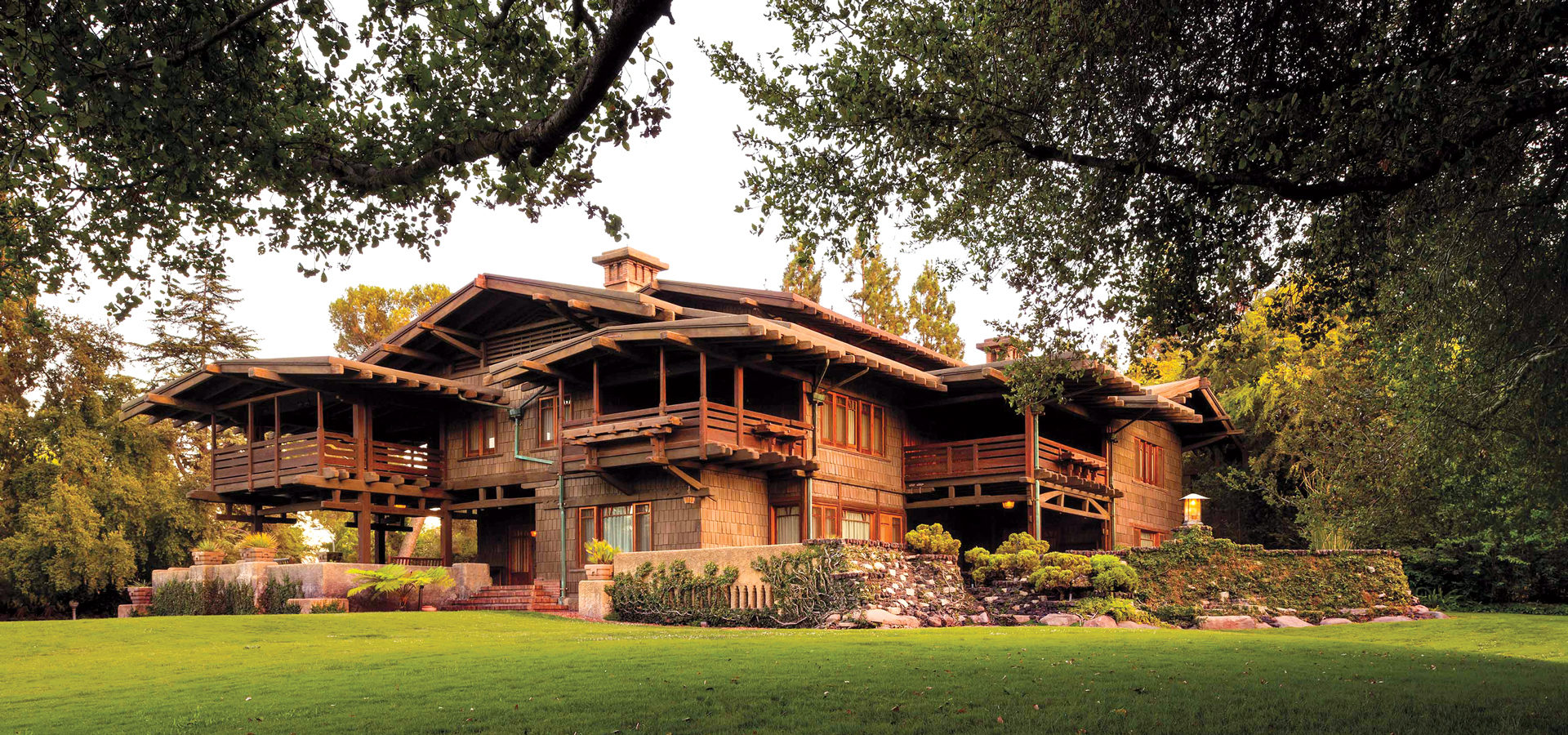
Visit the Historic Gamble House in Pasadena
It is an architectural gem.
- Posted on July 19, 2021
- Category Homes , People
- Written by Dakota Kim
- Photographs courtesy of The Gamble House
- Above The Gamble House facade features low-slung roofs that resemble pagodas
Upon first glance, you might not notice Japanese influences in the design and architecture of The Gamble House, Pasadena’s stately and historical Arts and Crafts landmark. But with a guided eye, details come to life, from a stained glass tree on the front door that resembles a Japanese black pine to the pagoda-like appearance of the low-slung roofs.
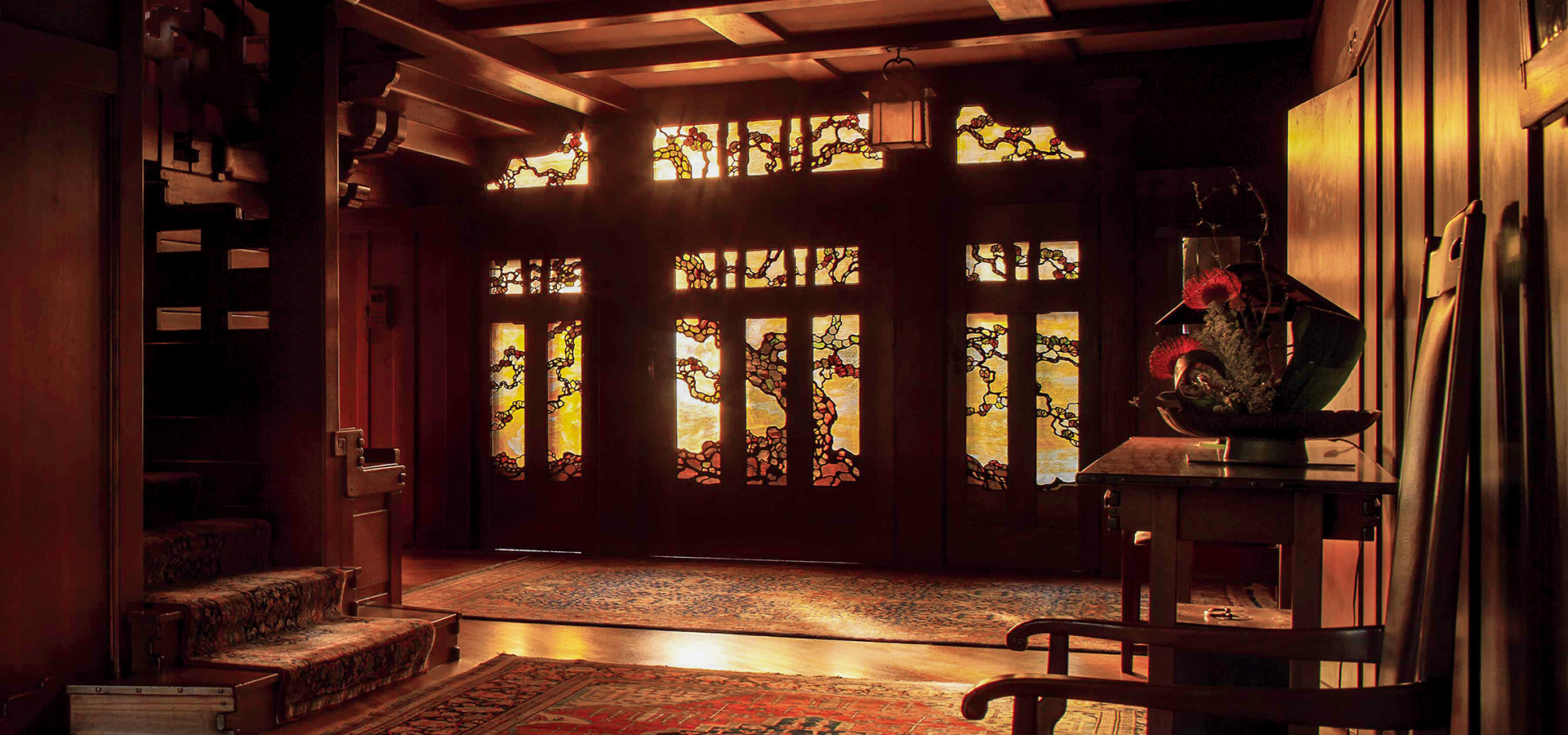
Above: The Gamble’s entry features a stained glass tree on the front door that resembles a Japanese black pine.
Brothers and architectural partners Charles Sumner Greene (1868–1957) and Henry Mather Greene (1870–1954), who established their esteemed firm Greene & Greene in 1894, designed this National Historic Landmark and California Historic Landmark, considered one of the finest examples of Arts and Crafts architecture in America.
“They were influenced by ancient wood-building cultures, but they were building in the moment of 1908, and trying to create something entirely new and beautiful and appropriate.”
From afar, it is easy to mistake the 8,100-square-foot building for a museum. But Greene & Greene designed it as a single-family home, built in 1908 for Procter & Gamble heir David Gamble and his wife, Mary, as a winter residence away from their home in Cincinnati. The brothers carefully consulted with the couple to add elements of grace and craft, according to Edward R. Bosley, executive director of The Gamble House. Those elements include several Japanese design features, including the small pond on the back patio that reinforces the Shinto idea of integration with nature, and the asymmetrical rear view that reflects the Buddhist conception of wabi-sabi, or finding beauty in the imperfection of nature.
The Greenes first began learning about Japanese architecture and design as students at MIT—then located in Boston—which they attended from 1888 to 1893. “Indeed, all over Boston, Japan was in the air, and the Greenes were breathing it,” Bosley says.
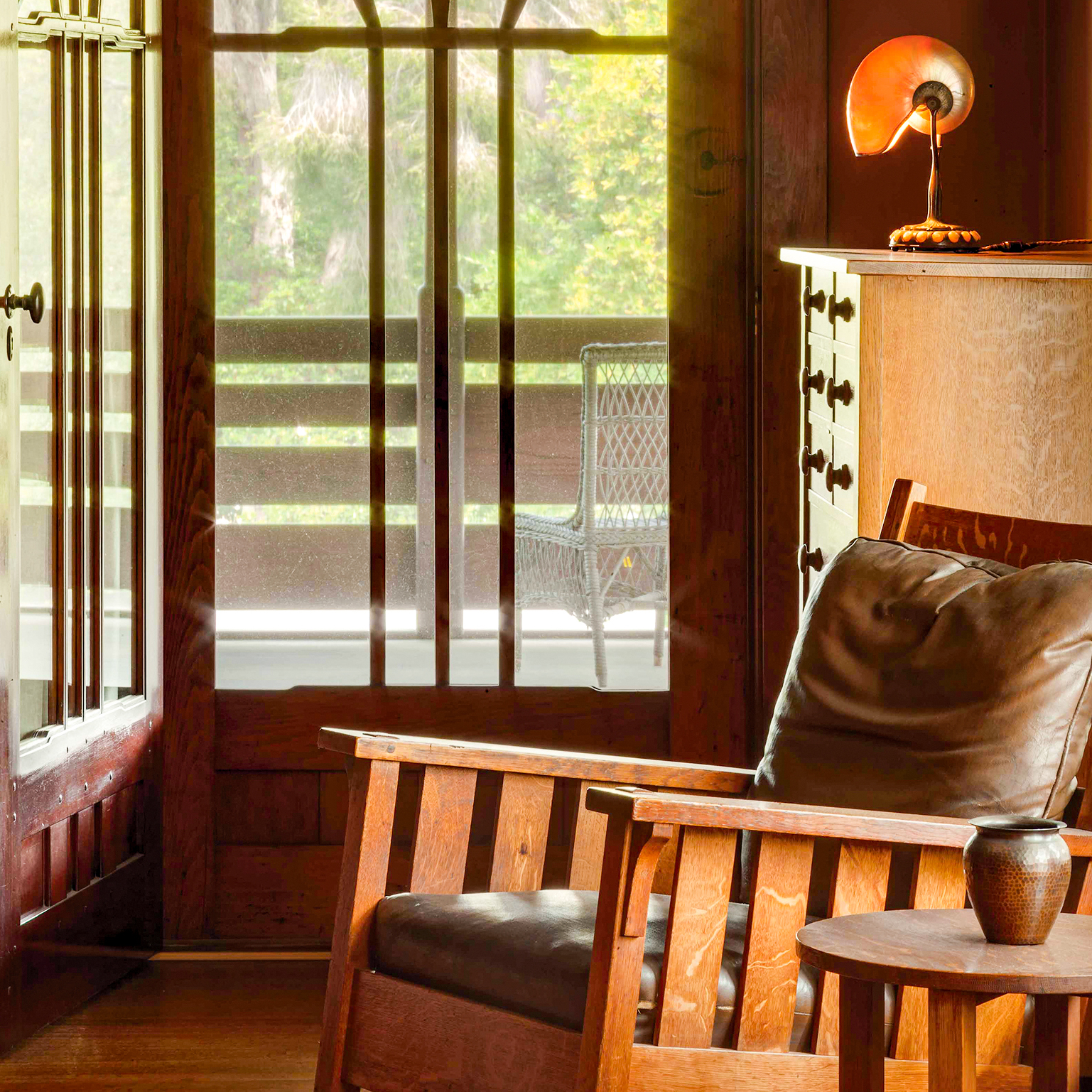
After their graduation, the Greene brothers proceeded to tour a variety of Japanese design wonders. They attended the 1893 Chicago World’s Columbian Exposition, viewing the Ho-o-den, or Phoenix Hall, a scaled-down version of the Ho-o-do Temple in Japan, which inspired what Bosley calls “a generation of Japanese-esque houses built in the (Phoenix Hall’s) wake.” In 1894, they visited the Midwinter Exposition in Golden Gate Park, where they toured the Japanese Hagiwara Tea Garden. And in 1901, Charles and his wife, Alice, visited the Pan-American International Exposition in Buffalo, New York, where they witnessed the Japanese Midway Exhibit.
As the story goes, Charles was summoned in 1904 by client Adelaide Tichenor to the St. Louis World’s Fair to see the building at the Japanese Imperial Garden which, she shared, was composed of many types of wood. Supposedly, no two types were from the same tree. “I do not want you to go on with my home until you see the Fair,” she wrote to him. “You will be able to get so many ideas of woods and other things for finishing what you now have on. It will be impossible for me to describe to you the effect of the woods.” That visit resulted in a Greene-designed structure for Tichenor with clear Japanese inspirations: various types of wood coexisting in harmony, a tile Irimoya roof, and a garden courtyard featuring a half-moon shape.
Bosley points to the wood structures of The Gamble House to illustrate how the Greenes were influenced by other wood-building cultures, including China, Korea, Switzerland and Japan. From the Douglas fir structural timbers to the redwood exterior shingles to the Burmese teak panels and mahogany furniture and paneling in the living room, building in wood was a central part of the Greenes’ philosophy, as in Japan. “They were influenced by ancient wood-building cultures, but they were building in the moment of 1908, and trying to create something entirely new and beautiful and appropriate,” Bosley notes.
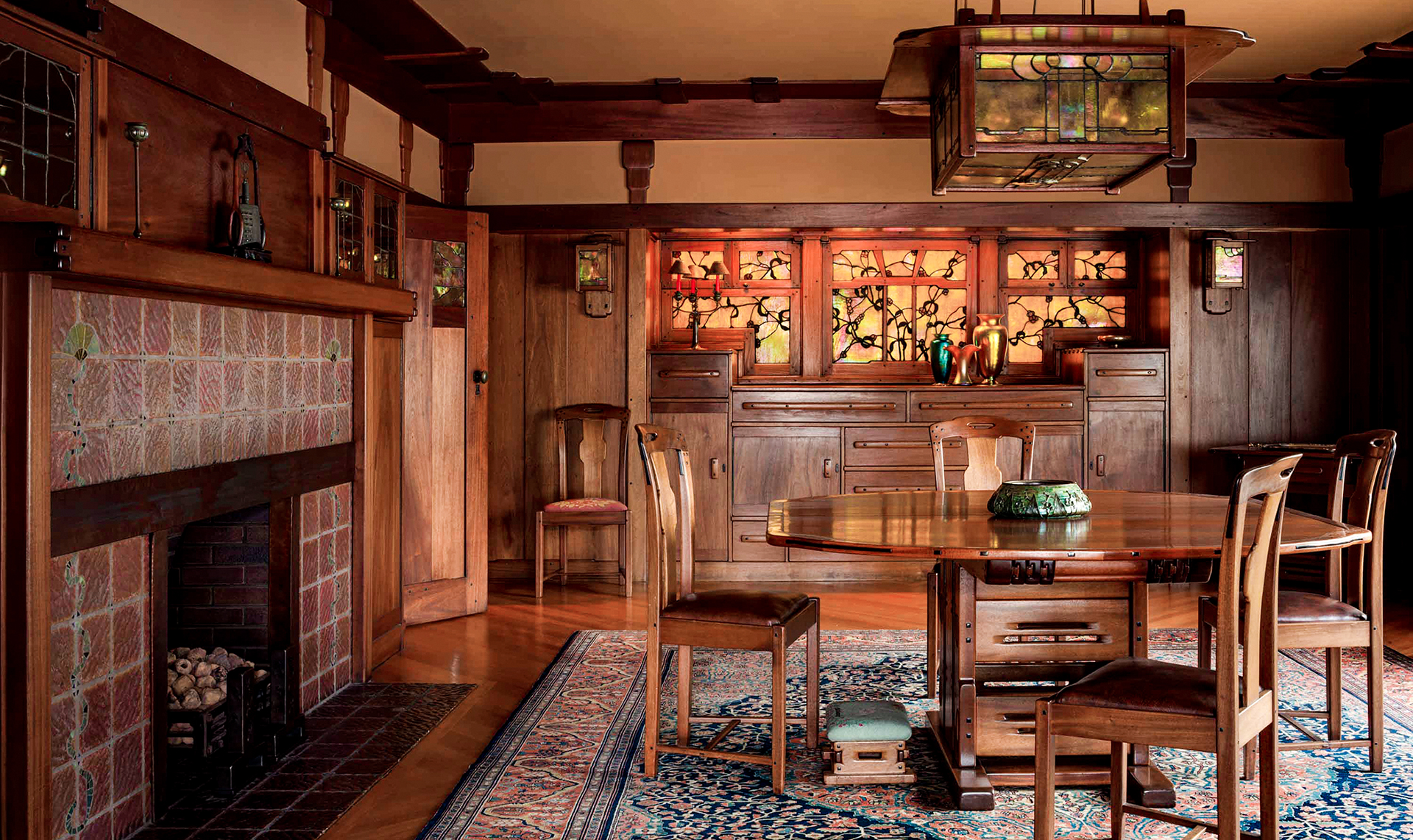
Above: The dining room at the Gamble House
The Greenes’ inspiration from Japanese architecture wasn’t limited to sourcing of building materials. Craftsmanship was viewable to the naked eye in the American Crafts movement, and that was reflected in the exposed outdoor beams that fit perfectly together, buttressing outdoor sleeping porches. Beyond the porches, a view of the gardens and landscaping showcased Japanese-style natural harmony.
“Where the Greene’s architecture really excels is that it did not ignore the landscape around the houses—on the contrary, it was very conscious of it,” Bosley says. Though clients sometimes complained that it took the Greenes too long to decide where in the landscape to place a house, the pair were determined to carefully consider views of the house from a number of perspectives, as well as how the house connected to the land. In the case of The Gamble House, the architects considered the home’s relationship with not only the immediate landscape, but also the surrounding landscape of the San Gabriel Mountains and the Arroyo Seco.
To Bosley, the pond on the rear patio is clear evidence of Japanese influence on The Gamble House. “The stones in the pond have surfaces that rise above the surface of water,” Bosley explains. “These become stepping-stones in the pond itself, a feature you see in some Japanese gardens.”
Even before The Gamble House, Charles Greene had become curious about Japanese design and incorporated it into several other homes. He had purchased Edward Sylvester Morris’ book Japanese Homes and Their Surroundings , showing how foundation stones were pounded into place. “This was apparently a revelation for Greene and had an immediate impact on his work,” Bosley says, referring to stone feet Charles later designed for posts at the Arturo Bandini house in Pasadena and the Cora Hollister house in Hollywood.
Bosley also points to the 16 carvings at the frieze level of the Gamble House’s living room—carvings that are similar in concept to panels in Japanese homes called ramma .
As shaped as they were by Japanese architecture and art, the Greene brothers wrote little about how Japanese style influenced them. “They weren’t very forthcoming about why they did what they did,” Bosley concludes. “Their work speaks for them most eloquently.”

Adriano Goldschmied is Known as the Godfather of Denim
Slip on your AG’s.

Architect May Sung Comes to The Rescue on a Studio City Reno Gone Wild
In the right hands…finally!

Cleveland Charter High School’s Marching Band Earns Accolades
Join the valley community.

Pasadena, CA: Gamble House
Online house tour.
The Gamble House in Pasadena, California is an internationally renowned example of American Arts & Crafts architecture and design. Architects and brothers Charles and Henry Greene (of the firm Greene & Greene) designed the house and its furnishings in 1908 as a winter residence for David and Mary Gamble of Cincinnati, Ohio.
The architects worked closely with the couple in the design of the house, even incorporating a family crest among the motifs. The design demonstrated the Gambles’ love of nature and the Southern California landscape, depictions of which in wood, metal, art glass and semi-precious stones are woven throughout the interiors. Other artistic themes of the house are drawn from Japanese art and focus on the use of natural materials, attention to detail, and fine craftsmanship. The critical relationship between indoor and outdoor living spaces is another hallmark.
Join Royal Oak for a virtual tour to this National Historic Landmark by Jennifer Trotoux, Director of Collections, Gamble House. We will explore the residence with its open and spacious rooms, filled with furnishings designed by the architects just for this commission and woodwork of extraordinary detail and finish quality. The program will include an illustrated talk about the house’s story followed by a live look at some of the significant spaces and features of the interior.
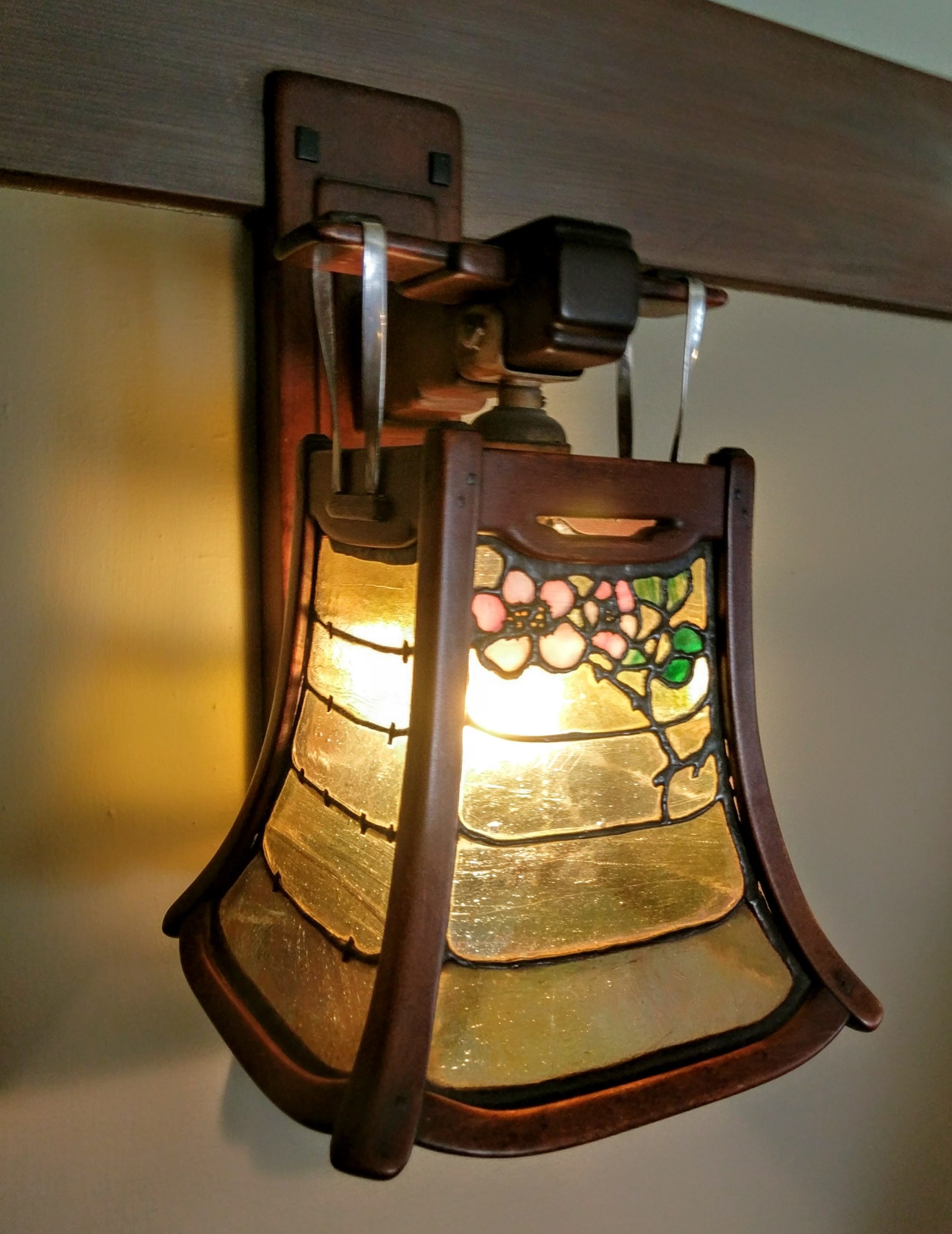
Tuesday, November 16 | 4:00 p.m. EST
Online via zoom webinar.
$30 Royal Oak members only
Register for Live
Between Wednesday, November 17 to Friday, November 19
Rent the recorded tour to watch at your leisure.
Register to Rent
The Zoom video link will be sent to you on Wednesday, November 17 at 11:00 a.m. (eastern).

This website uses analytical and tracking cookies to improve your user experience and for statistical purposes. By continuing to browse on this website, you agree to the use of such cookies.
Please check your membership status in My Account and click the Renew button if your membership has not lapsed.

Taking The Gamble House “Upstairs-Downstairs” Tour
The Gamble House has long been a favorite of mine. This perfectly preserved Arts and Crafts gem in the heart of Pasadena is one of the most beautiful places I have ever visited and I consider it one of the “must see” sites in the Los Angeles area.
Recently I was informed that the home would be offering a limited run “Upstairs-Downstairs” tour offering access to areas previously off limits. I knew there was no way I could miss it so I headed to Pasadena today to check it out.
We entered the home through the servants entrance. The Gamble House had only two full time servants who were treated well by the standards of the day. Their entrance swings by a small dining area…
and into the beautiful sun-filled kitchen.
There are so many elements of this room that I love. From the stove
to the intercom system
to the community cookbook featuring a recipe from Mrs. Gamble.
They hired the famed architects Greene and Greene to design and build the house in 1908. It remained in the family until 1966 when it was deeded to the City of Pasadena and USC School of Architecture.
USC operates the house and every year two lucky architecture students are invited to live there. They occupy the two servants rooms on the second floor.
The rooms are relatively small but retain the fine craftsmanship found throughout the rest of the home. I want to enroll in the School of Architecture just so I can have a chance to live here.
The servants quarters are on the same floor as the family’s although they are not as well appointed.
Like the Lanterman House in La Canada Flintridge, The Gamble House also contains sleeping porches. These porches are located off the bedrooms and are where the family would sleep during the summer.
The “Upstairs-Downstairs” tour is not to be missed. It offers a fascinating glimpse into life at the turn of the last century and showcases the Arts and Crafts movement in all it’s glory.
Beautiful. Just beautiful.
The “Upstairs-Downstairs” tour runs until Sunday, August 18th. Admission is $20 (free for children 12 and under). Tour times are Tuesdays 12:15 and 12:45 and Thursday thru Sunday every half hour from 11-3.
The Gamble House 4 Westmoreland Place Pasadena, CA 91103
Looking for more content?
Leave a reply cancel.
Notify me of follow-up comments by email.
Notify me of new posts by email.
This site uses Akismet to reduce spam. Learn how your comment data is processed .
- Spring Tour
- Become a Member
- Classes & Events
- Weddings & Rentals
- Support Us